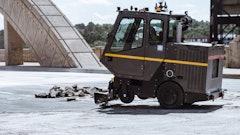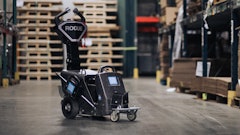Shot blasters are designed to lean and profile a concrete surface in a single step, making them a popular choice with contractors during floor preparation. These machines propel small round steel media, like small metal BBs, at the floor’s surface, hitting the floor before rebounding upwards. They are ideal for removing existing coatings while simultaneously preparing the surface for a new coating, such as an epoxy.
Shot blasters are built for effective preparation, but in my experience, there are a handful of issues that contractors commonly run into on-site that can be avoided with preparation.
On-site Issues
The most common problem contractors experience when using a shot blaster on-site is equipment ‘dropping shot’ or ‘puking’. This happens when shot rebounds erratically and remains lying on the surface instead of being drawn back up into the hopper, creating a barrier to removing the coating. This often occurs on soft surfaces like glue, or uneven surfaces, like very rough or tined concrete, so contractors should consider using other tools on these coverings, like scrapers or grinders.
Shot blasters also work best when traveling forward and in a straight line. Attempting to drive a self-propelled machine through curves, or reverse, could result in dropped shot. Instead, contractors can use an up-and-down pattern, always moving away from the vacuum to protect the power cable, leaving the turning points until the end.
Regular maintenance of machine parts, like the blast wheel, is also essential to maintain proper function. Unlike some machinery, contractors can conduct shot blaster maintenance on-site because complete disassembly is not usually required. Although they can initially seem complicated, contractors can tension belts and change blast wheels and liners on the job, minimizing downtime.
Shot Blasters Don’t Suck
A shot blaster needs sufficient dust collection to operate correctly and the bigger the tool’s footprint, the higher the spec of the required dust collector. If a dust collector is too small for the job, has dirty filters, or needs maintenance, it will be difficult to vacuum the space. Any dust left on the surface requires additional labor to clean up, or it could cycle through the machine and cause wear and tear by abrading the interior surfaces.
Furthermore, any dust recirculating through the blaster can require the machine to work harder, and this increased power load can cause a site’s circuit breakers to trip, disrupting work elsewhere. Dust collector maintenance and using separate power supplies with separate breakers for the shot blaster and the dust collector can help prevent tripping.
Feel The Power
Naturally, bigger shot blasters require more power, and the size of the job will dictate the most appropriate shot blaster. For example, small, 110V blasters can cover around 400 square meters an hour, while large machines running on 480V three-phase power can cover 30,000 square meters an hour.
Contractors should choose the machine most suited to the job and ensure the correct power supply is available before starting work. A machine being fed insufficient power will either work improperly or not at all. For instance, a self-propelled machine might move, but the blast wheel probably won’t start firing shot. Contractors should also consider what power cord they use. A longer cord might make it easier to navigate the site but it may also slow down the machine — using the supplied cord could improve machine efficiency.
Just like with toddlers, while they may seem complicated and finickity at first, taking the time to understand what makes a shot blaster tick can make a contractor’s life much easier.




























